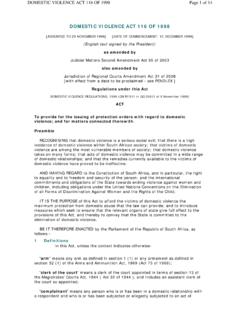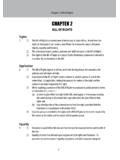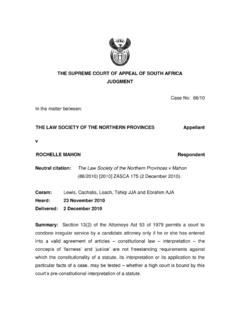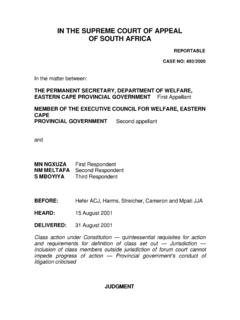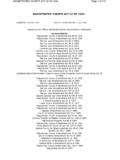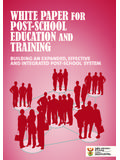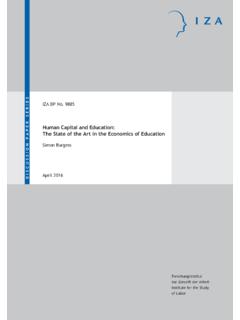Transcription of Policy Overview of the Post -School Education and Training ...
1 Policy Overview of the post -School Education and Training System - Presentation to the Presidential Commission on Higher Education : 4 October 2016 1 Establishment of the DHET in 2009 The post school Education and Training (PSET) system comprises: Higher Education (HE), offered by 26 universities (public Higher Education Institutions (HEIs)) and Private HEIs (PHEIs) Technical and Vocational Education and Training (TVET), offered by 50 public TVET Colleges and Private Colleges; Community Education and Training (CET), offered by 9 public CET Colleges, incorporating 3 276 learning centres; Sector Education and Training Authorities (SETAs) and the National Skills Fund (NSF).
2 And Regulatory bodies responsible for qualifications and quality assurance in the post -School system oCouncil on Higher Education (CHE), othe South African Qualifications Authority (SAQA) oQuality Council for Trades and Occupation (QCTO) oUmalusi 2 post -School Education and Training System PSET System: Shape and Size 3 Higher Education +/- 1 111 711 (2014) TVET +/- 789 530 CET Colleges: 275 268 (2014) NDP/WP Targets: Higher Education : m TVET colleges: m CET colleges: 1 m NSC qualifying for university entrance = +/- 30% of NSC passes 70% must be catered for by TVET Citizens with no NSC CET Sector Education and Training Authorities National Skills Fund 26 Universities: 969 154 114 PHEIs: 142 557 PSET System to cater for +/- 18 million citizens 50 TVET Colleges: 710 535 (2015) 627 Private Colleges: 78 995 (2014) QCs: SAQA, CHE, QCTO Levy Grant Institutions(SETAs and NSF) The DHET derives its mandate from Section 29 of the supreme law of the Republic, the Constitution.
3 Everyone has a right (a)to a basic Education , including adult basic Education , and (b) further Education , which the state, through reasonable measures, must make progressively available and accessible. Everyone has the right to receive Education in the official language or language of their choice in public educational institutions where that Education is reasonably practicable. In order to ensure effective access to, and implementation of this right, the state must consider all reasonable educational alternatives, including single medium institutions, taking into account equity, practicability and the need to redress the results of past racially-discriminatory laws and practices 4 Legislative Mandate White paper for post school Education and Training (2014) National Development Plan 2030 Skills Development Act The National Student Financial Aid Scheme (NSFAS Act) The National Qualifications Framework Act (NQF Act)
4 CAS Policy RPL Policy + Articulation Policy Minimum Admission Requirements for Universities Workplace-based Learning Policy framework Higher Education Act (1997) White paper 3: A programme for the transformation of HE (1997) National Plan for Higher Education (2001) University Statutes Continuing Education and Training Act, 2006 (Act No. 16 of 2006) National Policy on Community Colleges 2016 5 Legislation and Policy An expanded, effective and integrated post -School Education and Training system. A post -School system that can assist in building a fair, equitable, non-racial, non-sexist and democratic South Africa (addressing poverty, inequity, and targeting unemployed youth) A single-coordinated post -School Education and Training system (collaboration, partnerships, career guidance, schooling, SETAs, WIL, articulation, Policy alignment, integrated information systems and skills planning) Expanded access, improved quality and increased diversity of provision (affordability, expansion, diversity)
5 A stronger and more cooperative relationship between Education and Training institutions and the workplace A post -School Education and Training system that is responsive to the needs of individual citizens and of employers in both public and private sectors, as well as broader societal and developmental objectives. 6 White paper PSET Policy Goals 7 National Plan for post -School Education and Training DHET is developing a National Plan for post -School Education and Training (NP-PSET), to be released early in 2017. The National Plan for 2017-2030 will be a Sector Plan, much like the National Plan for Higher Education (2001) in the sense that it will provide a blueprint for building an expanded, effective and integrated post -School system over the period to 2030.
6 The Plan aims to give effect to the Policy proposals of the White paper on post -School Education and Training released in 2014, and will therefore draw on a number of initiatives underway since the release of the White paper . While the HE system has been planned for some time, other parts of the sector are being properly planned for the first time. The major shift is that planning is taking place within the context of the new post -School system. 8 National Plan for post -School Education and Training The Plan process will need to consider growth and development scenarios for each sub-sector and the PSET sector as a whole. These scenarios will take account of the necessary financing of the sector, the staffing necessary to support PSET institutions, the infrastructure required for adequate provision and growth, and the broad sets of principles that will guide provision and integration.
7 We need to think about new ways of developing the sector to allow for effective integration and better articulation, and to find mechanisms to share resources and infrastructure to ensure sustainability and allow for growth across this diverse sector. The National Plan is still under development and is working towards a coherent set of sub-sector plans and an integrated plan to give effect to Policy goals, while recognising constraints. Will focus on providing strategic framework for growth and improvement. Treasury costing project has provided a set of costing and funding models that can be used to make strategic decisions about enrolment growth possibilities in constrained environment.
8 9 Policy Challenges: Technical and Vocational Education and Training Qualifications: which qualifications, responsiveness and relevance, coherence, articulation problems, foundational learning, higher level opportunities, need for stability (enrolment and PQM planning) Differentiation: who offers what and where (regional and national responsiveness) Curriculum relevance and design Staffing, teaching and learning and professional development Strengthening management and governance Workplace linkages Addressing student success and throughput Articulation- workplace and higher levels Expanded provision and access Re-designing certification and examination system- currently expensive and unwieldy.
9 Adequate financial support for delivery of qualifications and supporting level of improvement required. 10 Enrolment by Qualification 2010 - 2014 20102011201220132014 NCV130 039124 658140 575154 960166 433 Report 191169 774222 754359 624442 287486 933 OccupationalQualifications23 16020 79962 35919 00019 825 Other31 50432 06295 13223 37129 1920100 000200 000300 000400 000500 000600 00011 Main Policy goals: TVET Colleges Re-naming of FET Colleges as TVET Colleges. This has implications for mandate and provision. Strengthening Colleges: various strategies in place since 2012 improving governance, financial management. Increased access expansion of enrolments in TVET Colleges- has been substantial increase in enrolments - doubling between 2010 and 2014.
10 Improving quality: includes addressing curricula, staffing and student success. More coherent quality assurance regime. Role of SETAs in supporting workplace linkages Establishment of SAIVCET the entire gamut of occupational programmes and qualifications will therefore be reviewed and rationalised into a coherent and simple framework that fits easily into the NQF and makes learning pathways clear to school leavers and employers Improved data and information capacity 12 Main Policy challenges: Community Education and Training Creating a new type of institution established to address opportunities for youth and adults who did not finish or never attended school ; opportunities for those who cannot enter TVET colleges or universities.



